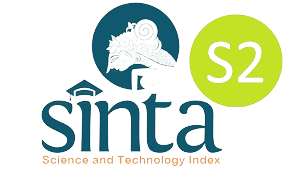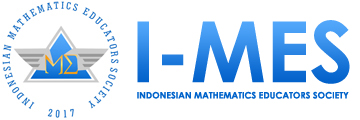Challenge-based learning assisted by virtual reality STEAM trails at a cultural heritage museum to promote mathematical creative thinking skills
DOI:
https://doi.org/10.29408/jel.v11i3.29778Keywords:
challenge-based learning, math trails, Pekalongan Batik Museum, STEAM, virtual realityAbstract
The 21st century requires every individual to possess creative thinking skills to face increasingly complex challenges. This skill can be developed through learning mathematics. This study aimed to determine the quality of challenge-based learning assisted by virtual reality STEAM Trails in the context of the Pekalongan Batik Museum to improve mathematical creative thinking skills. The method used in this study was design research. The participants of this study were 30 ninth-grade students at a junior high school in Pekalongan, Indonesia. The data collection techniques included validation sheets, questionnaires, and tests. Qualitative data analysis techniques were used to analyse the students' responses after learning. Quantitative data analysis techniques were used to analyse mathematical creative thinking skills based on the pretest and posttest results. Validity was analysed based on the validation results by three validators, and practicality was analysed based on the results of the practicality questionnaire by five students from the experimental group. The results of this study showed a significant increase in the pre- and post-test results. Additionally, the results of the student response questionnaire indicated high satisfaction with the learning process. Further research is needed to develop VR for other contexts.
References
Akman, E., & Çakır, R. (2023). The effect of educational virtual reality game on primary school students’ achievement and engagement in mathematics. Interactive Learning Environments, 31(3), 1467–1484. https://doi.org/10.1080/10494820.2020.1841800
Amirah, G., & Mahartika, I. (2025). Development of augmented reality-assisted practical guide media for thermochemistry practicum and its effectiveness in improving students’ learning outcomes. Jurnal Penelitian Pendidikan IPA, 11(2), 500–507. https://doi.org/10.29303/jppipa.v11i2.10044
Ardiansyah, A. S., & Asikin, M. (2020). Challenging students to improve their mathematical creativity in solving multiple solution task on challenge based learning class. Journal of Physics: Conference Series, 1567(2), 1–6. https://doi.org/10.1088/1742-6596/1567/2/022088
Bakker, A. (2018). Design research in education: A practical guide for early career researchers (1st ed.). In Routledge. https://doi.org/10.4324/9780203701010
Beemt, A. A. J. V. D., & MacLeod, M. A. J. (2021). Tomorrow’s challenges for today’s students: challenge-based learning and interdisciplinarity. 49th SEFI Annual Conference: Blended Learning in Engineering Education: Challenging, Enlightening-and Lasting?, 588–597.
Cahyono, A. N. (2024). VR STEM trail: A math trail-based STEM education using virtual reality technology for learning mathematical modelling bt - Augmented and virtual reality in mathematics education: International symposium on augmented and virtual reality 2022. (F. Dilling & I. Witzke (eds.); pp. 151–163). Springer Fachmedien Wiesbaden. https://doi.org/10.1007/978-3-658-45271-1_9
Cahyono, A. N., & Lavicza, Z. (2023). Designing landmark-based STEAM projects for cross-country math trail activities with augmented reality and 3D printing technologies. International Journal for Technology in Mathematics Education, 30(4), 241–246. https://doi.org/10.1564/tme_v30.4.6
Chen, S.-J., Chen, C.-Q., & Shan, X.-F. (2024). The effects of an immersive virtual-reality-based 3D modeling approach on the creativity and problem-solving tendency of elementary school students. Sustainability, 16(10), 1–16. https://doi.org/10.3390/su16104092
Crusat, X., & Martínez, I. M. (2021). Engaging students in COVID times with immersive learning and self-driven challenge-based learning. 2021 IEEE Global Engineering Education Conference (EDUCON), 1277–1281. https://doi.org/10.1109/EDUCON46332.2021.9453957
Erol, A., Erol, M., & Başaran, M. (2023). The effect of STEAM education with tales on problem solving and creativity skills. European Early Childhood Education Research Journal, 31(2), 243–258. https://doi.org/10.1080/1350293X.2022.2081347
Fairazatunnisa, F., Dwirahayu, G., & Musyrifah, E. (2021). Challenge based learning dalam meningkatkan kemampuan berpikir kreatif siswa pada materi persamaan linear satu variabel [challenge based learning in improving students’ creative thinking skills in one variable linear equation material]. Edukatif : Jurnal Ilmu Pendidikan, 3(5), 1942–1956. https://doi.org/10.31004/edukatif.v3i5.702
Faradillah, A., & Maulida, A. (2022). Students’ creative thinking ability assisted augmented reality based on visualizer-verbalizer cognitive style. Jurnal Elemen, 8(2), 659–674. https://doi.org/10.29408/jel.v8i2.5693
Ghoni, A. A., Hidayati, N., & Fitiatin. (2023). Eksplorasi etnomatematika di Museum Batik Pekalongan sebagai bahan pembelajaran matematika [exploration of ethnomathematics at the Pekalongan Batik Museum as mathematics learning material]. SANTIKA: Seminar Nasional Tadris Matematika, 3, 117–127.
Helker, Kerstin, Bruns, Miguel, Reymen, Isabelle M M J, & Vermunt, Jan D. (2024). A framework for capturing student learning in challenge-based learning. Active Learning in Higher Education, 26(1), 213–229. https://doi.org/10.1177/14697874241230459
Isyrofinnisak, F., Kusmayadi, T. A., & Fitriana, L. (2020). Mathematics creativity skill of student in junior high school based on students thinking style. Journal of Physics: Conference Series, 1538(1), 012068. https://doi.org/10.1088/1742-6596/1538/1/012068
Jacob, T., & Centofanti, S. (2024). Effectiveness of H5P in improving student learning outcomes in an online tertiary education setting. Journal of Computing in Higher Education, 36(2), 469–485. https://doi.org/10.1007/s12528-023-09361-6
Jiang, J., & Fryer, L. K. (2024). The effect of virtual reality learning on students’ motivation: A scoping review. Journal of Computer Assisted Learning, 40(1), 360–373.
Johar, R., Maisela, A., & Suhartati, S. (2023). Students’ creative thinking skill through realistic mathematics education on straight-line equation. Jurnal Elemen, 9(2), 334–350. https://doi.org/10.29408/jel.v9i2.7697
Khalishah, N., & Nalim, N. (2022). Studi etnomatematika konsep geometris dalam kearifan budaya lokal batik pekalongan [Ethnomathematical study of geometric concepts in the local cultural wisdom of Pekalongan batik]. SANTIKA: Seminar Nasional Tadris Matematika, 2, 390–400.
Liao, R. (2024). Virtual reality technology in art education system. In Design Studies and Intelligence Engineering (pp. 58–69). IOS Press. https://doi.org/10.3233/FAIA231425
Martinez, C. (2022). Developing 21st century teaching skills: A case study of teaching and learning through project-based curriculum. Cogent Education, 9(1), 1–16. https://doi.org/10.1080/2331186X.2021.2024936
Maryati, I., & Nurkayati, N. (2021). Analisis kemampuan berpikir kreatif matematis siswa sekolah menengah atas dalam materi aljabar [analysis of creative mathematical thinking ability of high school students in algebra material]. Pythagoras: Jurnal Matematika Dan Pendidikan Matematika, 16(2), 253–265. https://doi.org/10.21831/pythagoras.v16i2.40007
Musril, H. A., Jasmienti, J., & Hurrahman, M. (2020). Implementasi teknologi virtual reality pada media pembelajaran perakitan komputer [Implementation of virtual reality technology in computer assembly learning media]. Jurnal Nasional Pendidikan Teknik Informatika: JANAPATI, 9(1), 83–95. https://doi.org/10.23887/janapati.v9i1.23215
Muthmainnah, M., Cardoso, L., Marzuki, A. G., & Al Yakin, A. (2025). A new innovative metaverse ecosystem: VR-based human interaction enhances EFL learners’ transferable skills. Discover Sustainability, 6(1), 156–179. https://doi.org/10.1007/s43621-025-00913-7
Muttaqin, H., & Tohir, M. (2021). Students’ creative thinking skills in solving mathematics higher order thinking skills (HOTs) problems based on online trading arithmetic. Journal of Physics: Conference Series, 1832(1), 1–11. https://doi.org/10.1088/1742-6596/1832/1/012036
Nichols, M., Cator, K., Torres, M., & Henderson, D. (2016). Challenge based learner user guide. Redwood City, CA: Digital Promise, 1–59.
Nugroho, M. A., Yulandari, I., & Cahyono, A. N. (2024). Project-based learning through augmented reality-assisted math trails at Blenduk church to promote mathematical literacy. Jurnal Elemen, 10(2), 363–377. https://doi.org/10.29408/jel.v10i2.25333
Pocalana, G., Robutti, O., & Ciartano, E. (2024). Resources and praxeologies involved in teachers’ design of an interdisciplinary STEAM activity. Education Sciences, 14(3), 1–21. https://doi.org/10.3390/educsci14030333
Rodríguez-Nieto, C. A., & Alsina, Á. (2022). Networking between ethnomathematics, STEAM education, and the globalized approach to analyze mathematical connections in daily practices. Eurasia Journal of Mathematics Science And Technology Education, 2022, Vol. 18, Núm. 3. https://doi.org/10.29333/ejmste/11710
Romero Caballero, S., Canquiz Rincón, L., Rodríguez Toscano, A., Valencia Pérez, A., & Moreno Gómez, G. (2025). Challenge-based learning and design thinking in higher education: institutional strategies for linking experiential learning, innovation, and academic performance. Innovations in Education and Teaching International, 62(2), 557–574. https://doi.org/10.1080/14703297.2024.2326191
Sanusi, A. M., Septian, A., & Inayah, S. (2020). Kemampuan berpikir kreatif matematis dengan menggunakan education game berbantuan android pada barisan dan deret [Mathematical creative thinking skills using Android-assisted education games on sequences and series]. Mosharafa: Jurnal Pendidikan Matematika, 9(3), 511–520. https://doi.org/10.31980/mosharafa.v9i3.633
Suherman, S., & Vidákovich, T. (2022). Tapis patterns in the context of ethnomathematics to assess students’ creative thinking in mathematics: A Rasch measurement. Mathematics Teaching Research Journal, 14(4), 56–79.
Supena, I., Darmuki, A., & Hariyadi, A. (2021). The influence of learning model on students’ learning outcomes. International Journal of Instruction, 14(3), 873–892. https://doi.org/10.29333/iji.2021.14351a
Surmilasari, N., & Usman, H. (2022). Creative thinking with stem-based project-based learning model in elementary mathematics learning. Jurnal Pendidikan Dasar Nusantara, 7(2), 434–444. https://doi.org/10.29407/jpdn.v7i2.17002
Suryati, S., Pangga, D., Habibi, H., & Azmi, I. (2025). Digital pedagogical model based on climate change issues integrated with virtual reality technology to enhance students’ critical thinking and climate change awareness. International Journal of Ethnoscience and Technology in Education, 2(1), 1–28. https://doi.org/10.33394/ijete.v2i1.14054
Tang, J., Wijaya, T. T., Weinhandl, R., Houghton, T., Lavicza, Z., & Habibi, A. (2022). Effects of micro-lectures on junior high school students’ achievements and learning satisfaction in mathematics lessons. Mathematics, 10(16), 1–19. https://doi.org/10.3390/math10162973
Tsuchiya, K., & Gyobu, I. (2025). Activating STEAM learning in young children through aha-experiences: Supporting creativity and aesthetic sensitivity in infants and toddlers. Education Sciences, 15(2), 1–23. https://doi.org/10.3390/educsci15020117
Wahyudi, W., Waluya, S. B., Suyitno, H., & Isnarto, I. (2021). Schemata and creative thinking ability in cool-critical-creative-meaningful (3CM) learning. International Journal of Sustainability in Higher Education, 22(1), 1–28. https://doi.org/10.1108/IJSHE-06-2019-0198
Yang, Z., Zhou, Y., Chung, J. W. Y., Tang, Q., Jiang, L., & Wong, T. K. S. (2018). Challenge based learning nurtures creative thinking: An evaluative study. Nurse Education Today, 71, 40–47. https://doi.org/10.1016/j.nedt.2018.09.004
Yayuk, E., As’ ari, A. R., Purwanto, & Subanji. (2020). Primary school students’ creative thinking skills in mathematics problem solving. European Journal of Educational Research, 9(3), 1281–1295. https://doi.org/10.12973/eu-jer.9.3.1281
Yu, Z. (2023). A meta-analysis of the effect of virtual reality technology use in education. Interactive Learning Environments, 31(8), 4956–4976. https://doi.org/10.1080/10494820.2021.1989466
Yunianto, W., Cahyono, A. N., Prodromou, T., El-Bedewy, S., & Lavicza, Z. (2025). CT integration in STEAM learning: Fostering students’ creativity by making Batik stamp pattern. Science Activities, 62(1), 26–52. https://doi.org/10.1080/00368121.2024.2378860
Zhan, Z., Zhong, X., Lin, Z., & Tan, R. (2024). Exploring the effect of VR-enhanced teaching aids in STEAM education: An embodied cognition perspective. Computers & Education: X Reality, 4(2), 1–13. https://doi.org/10.1016/j.cexr.2024.100067
Downloads
Published
How to Cite
Issue
Section
License
Copyright (c) 2025 Andy Nova Winasis, Asri Rejeki, Adi Nur Cahyono

This work is licensed under a Creative Commons Attribution-ShareAlike 4.0 International License.
Authors who publish with the Jurnal Elemen agree to the following terms:
- Authors retain copyright and grant the journal right of first publication with the work simultaneously licensed under Creative Commons Attribution-ShareAlike 4.0 International License (CC BY-SA 4.0).
- Authors are able to enter into separate, additional contractual arrangements for the distribution of the journal's published version of the work (e.g., post it to an institutional repository or publish it in a book), with an acknowledgment of its initial publication in this journal.
- Authors are permitted and encouraged to post their work online (e.g., in institutional repositories or on their website) prior to and during the submission process, as it can lead to productive exchanges, as well as earlier and greater citation of published work.
Jurnal Elemen is licensed under a Creative Commons Attribution-ShareAlike 4.0 International License





